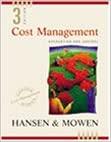Answered step by step
Verified Expert Solution
Question
1 Approved Answer
The reconciliation that explains the difference in the absorption and variable costing net operating incomes will be explained in a multi-step process as follows: Calculate



| The reconciliation that explains the difference in the absorption and variable costing net operating incomes will be explained in a multi-step process as follows: | |||||||||||||
| Calculate the fixed portion of the predetermined overhead rate as follows: | |||||||||||||
| Total budgeted fixed manufacturing overhead (a) | |||||||||||||
| Total budgeted direct labor-hours (b) | |||||||||||||
| Fixed portion of the predetermined overhead rate (rounded) (a) (b) | |||||||||||||
| Calculate the amount by which the number of units produced during the year exceeds the number of units sold: | |||||||||||||
| Total units produced (see production budget) | |||||||||||||
| Total units sold (see production budget) | |||||||||||||
| Units produced in excess of unit sales | - | ||||||||||||
| Culate the amount of fixed manufacturing overhead that will be attached to each unit produced during 2022: | |||||||||||||
| Fixed portion of the predetermined overhead rate (rounded) (a) | |||||||||||||
| Budgeted direct labor-hours per unit (b) | |||||||||||||
| Budgeted fixed manufacturing overhead per unit (a) * (b) | |||||||||||||
| Calculate the amount of fixed manufacturing overhead that will be attached to the 450 units that are produced during the year and retained in ending finished goods inventory as of December 31, 2022: | |||||||||||||
| Units produced and unsold (a) | 450 | ||||||||||||
| Budgeted fixed manufacturing overhead per unit (b) | - | ||||||||||||
| Budgeted fixed manufacturing overhead deferred in ending inventory (rounded) (a) (b) | |||||||||||||
| Reconcile the variable and absorption costing net operating incomes as follows: | |||||||||||||
| Variable costing net operating income | |||||||||||||
| Add fixed manufacturing overhead cost deferred in inventory under absorption costing | |||||||||||||
| Absorption costing net operating income | - | ||||||||||||
Step by Step Solution
There are 3 Steps involved in it
Step: 1

Get Instant Access to Expert-Tailored Solutions
See step-by-step solutions with expert insights and AI powered tools for academic success
Step: 2

Step: 3

Ace Your Homework with AI
Get the answers you need in no time with our AI-driven, step-by-step assistance
Get Started


